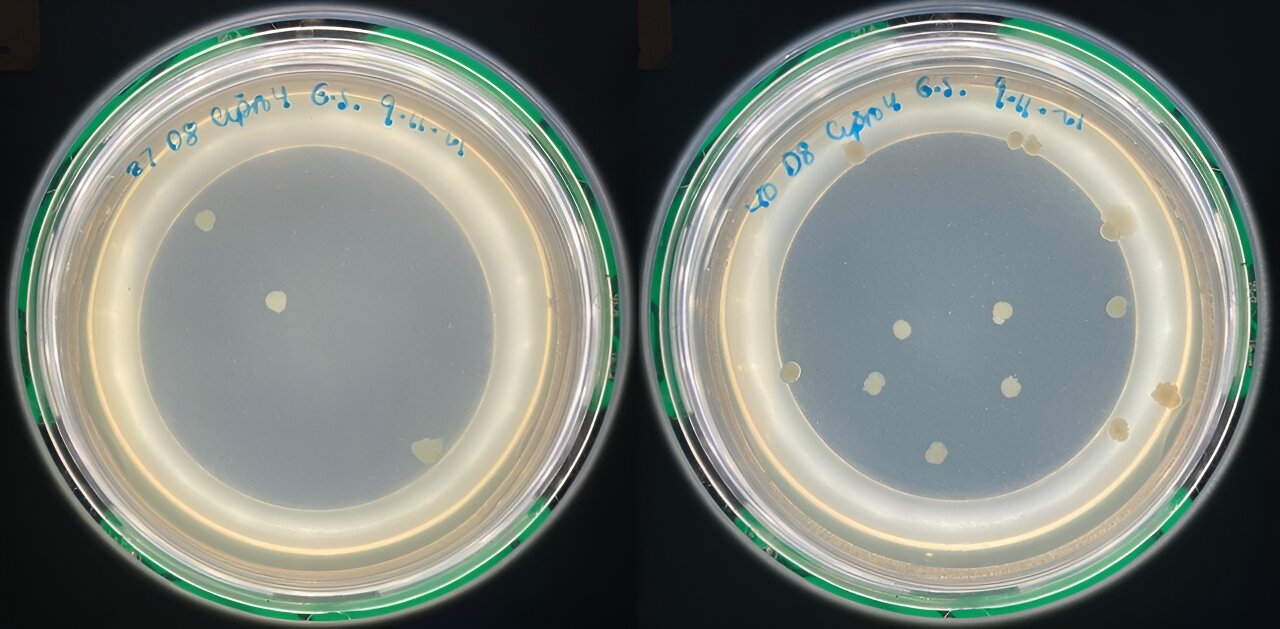Colonies of the bacterium E. coli growing on an agar plate with ciprofloxacin: these resistant colonies come from mutants. On the left the resistant mutants from a population grown at 37 °C (normal body temperature), on the right the resistant mutants from a population grown at 40 °C (fever temperature). Credit: Eleanor Sheridan / University of Groningen
× close to
Colonies of the bacterium E. coli growing on an agar plate with ciprofloxacin: these resistant colonies come from mutants. On the left the resistant mutants from a population grown at 37 °C (normal body temperature), on the right the resistant mutants from a population grown at 40 °C (fever temperature). Credit: Eleanor Sheridan / University of Groningen
Scientists from the University of Groningen (Netherlands), together with colleagues from the University of Montpellier (France) and the University of Oldenburg (Germany), tested how fever can influence the development of antimicrobial resistance.
In laboratory experiments, they found that a small increase in temperature from 37 to 40 degrees Celsius dramatically changed the mutation frequency in E. coli bacteria, facilitating the development of resistance. If these results can be replicated in human patients, fever management could provide a new way to reduce the emergence of antibiotic resistance. The results were published in the journal JAC-Antimicrobial resistance.
Antimicrobial resistance of pathogens is a global problem and is recognized by the WHO as one of the greatest global threats to public health and development. There are two ways to combat this: by developing new medicines, or by preventing the development of resistance.
“We know that temperature affects the mutation rate in bacteria,” explains Timo van Eldijk, co-first author of the paper. “What we wanted to discover was how the temperature increase associated with fever affects the mutation rate toward antibiotic resistance.”
“Most studies of resistance mutations have been done by lowering the ambient temperature, and to our knowledge, no study has used a moderate increase above normal body temperature,” reports Van Eldijk. Together with master’s student Eleanor Sheridan, Van Eldijk grew the E. coli bacteria at 37 or 40 degrees Celsius, and then exposed them to three different antibiotics to assess the effect.
He adds: “Again, previous human studies have looked at temperature and antibiotics, but these studies did not control for the type of drug.” In their laboratory research, the team used three different antibiotics with different mechanisms of action: ciprofloxacin, rifampicin and ampicillin.
The results showed that for two of the drugs, ciprofloxacin and rifampicin, increased temperature led to an increase in the mutation rate towards resistance. However, the third drug, ampicillin, caused a decrease in the mutation rate toward resistance at febrile temperatures.
“To be sure of this result, we repeated the study with ampicillin in two different laboratories, at the University of Groningen and the University of Montpellier, and got the same result,” says Van Eldijk.
The researchers hypothesized that a temperature dependence of ampicillin’s efficacy could explain this result, and confirmed this in an experiment. This explains why ampicillin resistance develops less quickly at 40 degrees Celsius.
“Our research shows that a very mild temperature change can drastically change the mutation rate towards resistance to antimicrobials,” concludes Van Eldijk. “This is interesting because other parameters, such as growth rate, don’t seem to change.”
If the results are replicated in humans, it could open the way to tackling antimicrobial resistance by lowering temperatures with fever-suppressing drugs, or by giving patients with fever antimicrobial drugs with higher efficacy at higher temperatures. The team concludes in the paper: “An optimized combination of antibiotics and fever suppression strategies may be a new weapon in the fight against antibiotic resistance.”
More information:
Timo JB Van Eldijk et al., Temperature dependence of the mutation rate with respect to antibiotic resistance, JAC-Antimicrobial resistance (2024). DOI: 10.1093/jacamr/dlae085
